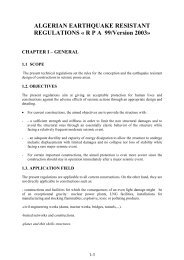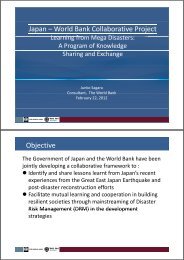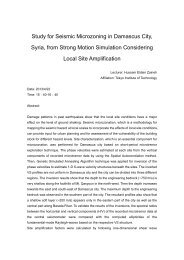DESIGN SPECIFICATIONS FOR HIGHWAY BRIDGES - IISEE
DESIGN SPECIFICATIONS FOR HIGHWAY BRIDGES - IISEE
DESIGN SPECIFICATIONS FOR HIGHWAY BRIDGES - IISEE
You also want an ePaper? Increase the reach of your titles
YUMPU automatically turns print PDFs into web optimized ePapers that Google loves.
Table 11.2.1 Ratio (r) of the Secondary Post-Yielding Stiffness to the Yielding Stiffness<br />
Used in Calculation of the Residual Displacement of a Steel Pier,<br />
and Residual Displacement Modification Factor (CR)<br />
Type of steel piers r c R<br />
Steel piers without concrete filling 0.2 0.45<br />
Steel piers with concrete filling 0.05 0.35<br />
2) In verification of Seismic Performance Level 3, the maximum response of a<br />
steel pier obtained from a dynamic analysis shall not exceed its allowable value.<br />
(2) Allowable values such as allowable displacements of a steel pier for verifying the<br />
Seismic Performance Level 2 or Level 3 shall generally be determined in accordance<br />
with the results of repeating load test for specimens having structural details<br />
similar to those of the real pier. Allowable residual displacement shall not exceed<br />
one hundredth of the height from the pier base to the height of the superstructural<br />
inertia force.<br />
(3) An inelastic hysteretic model of a steel pier in a dynamic analysis shall represent<br />
allowable values such as allowable displacements obtained from test results<br />
specified in (2), and elasto-plastic behavior of the steel pier.<br />
11.3 Structural Details<br />
(1) Low-strength concrete is recommended for filling concrete inside steel piers.<br />
Concrete shall be filled up to a height capable of preventing the buckling of a steel<br />
section just above the concrete filling.<br />
(2) Structural details of hollow steel piers shall follow the provisions in Sections 4.2<br />
and 14.3 of Part II Steel Bridges, and shall avoid brittle failure, and enhance their<br />
ductile properties.<br />
11.4 Design for Anchorage Block<br />
Anchorage block of a steel pier shall generally be designed with strength not less than<br />
the lateral strength of the steel pier. When concrete is filled into the foundation, the<br />
strength of the steel pier shall be calculated by taking the effects of the filled concrete<br />
into account.<br />
67








